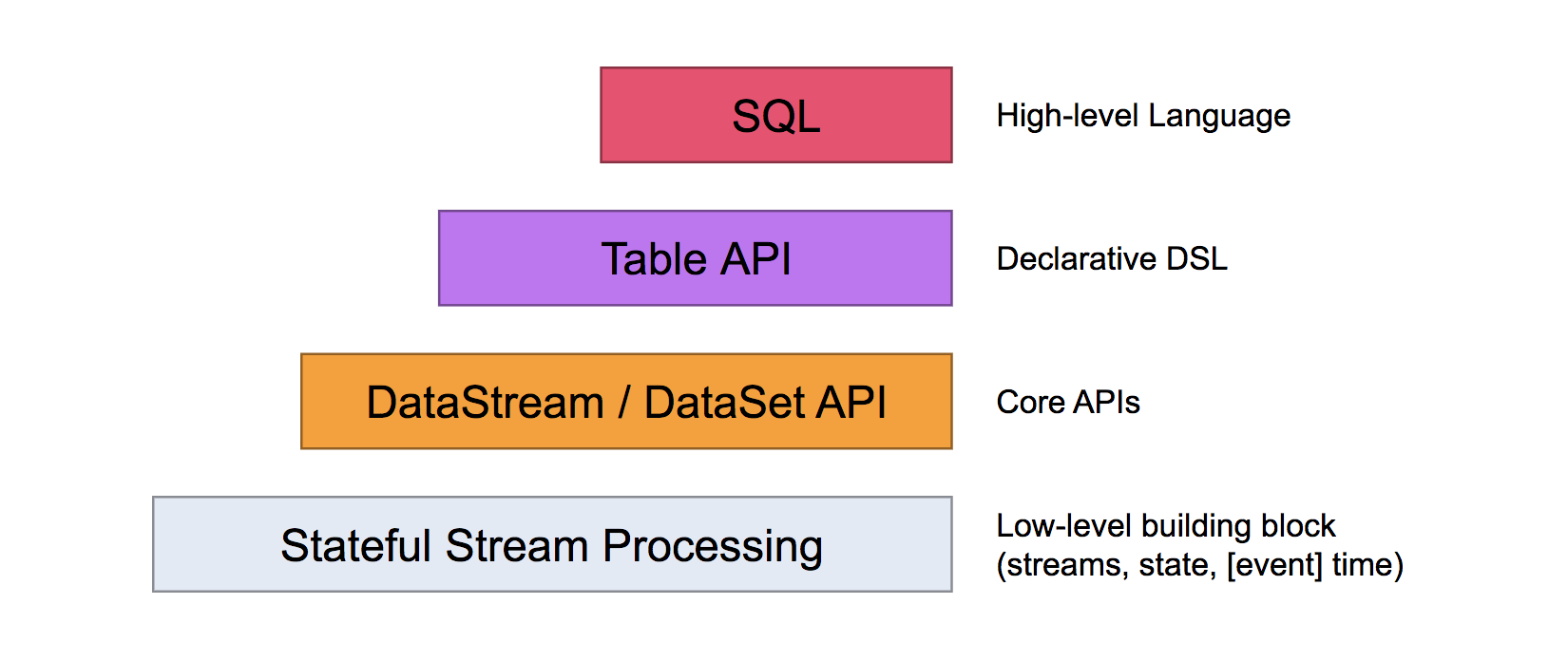Flink(四) —— 数据流编程模型
分层抽象

The lowest level abstraction simply offers stateful streaming. It is embedded into the DataStream API via the Process Function. It allows users freely process events from one or more streams, and use consistent fault tolerant state. In addition, users can register event time and processing time callbacks, allowing programs to realize sophisticated computations.
最低层次的抽象仅提供有状态流。它通过Process函数嵌入到DataStream API中。它允许用户自由地处理来自一个或多个流的事件,并使用一致的容错状态。此外,用户可以注册事件时间和处理时间回调,允许程序实现复杂的计算。
In practice, most applications would not need the above described low level abstraction, but would instead program against the Core APIs like the DataStream API (bounded/unbounded streams) and the DataSet API (bounded data sets). These fluent APIs offer the common building blocks for data processing, like various forms of user-specified transformations, joins, aggregations, windows, state, etc. Data types processed in these APIs are represented as classes in the respective programming languages.
在实践中,大多数应用程序不需要上面描述的低级抽象,而是对核心API进行编程,比如DataStream API(有界或无界数据流)和DataSet API(有界数据集)。这些API提供了用于数据处理的通用构建块,比如由用户定义的多种形式的转换、连接、聚合、窗口、状态等。在这些api中处理的数据类型以类(class)的形式由各自的编程语言所表示。
The low level Process Function integrates with the DataStream API, making it possible to go the lower level abstraction for certain operations only. The DataSet API offers additional primitives on bounded data sets, like loops/iterations.
低级流程函数与DataStream API集成,使得只对某些操作进行低级抽象成为可能。DataSet API为有界数据集提供了额外的原语,比如循环或迭代。
The Table API is a declarative DSL centered around tables, which may be dynamically changing tables (when representing streams). The Table API follows the (extended) relational model: Tables have a schema attached (similar to tables in relational databases) and the API offers comparable operations, such as select, project, join, group-by, aggregate, etc. Table API programs declaratively define what logical operation should be done rather than specifying exactly how the code for the operation looks. Though the Table API is extensible by various types of user-defined functions, it is less expressive than the Core APIs, but more concise to use (less code to write). In addition, Table API programs also go through an optimizer that applies optimization rules before execution.
Table API是一个以表为中心的声明性DSL,其中表可以动态地改变(当表示流数据时)。表API遵循(扩展)关系模型:表有一个附加模式(类似于关系数据库表)和API提供了类似的操作,如select, project, join, group-by, aggregate 等。Table API 程序以声明的方式定义逻辑操作应该做什么而不是指定操作的代码看起来如何。虽然Table API可以通过各种用户定义函数进行扩展,但它的表达性不如核心API,但使用起来更简洁(编写的代码更少)。此外,Table API程序还可以在执行之前通过应用优化规则的优化器。
One can seamlessly convert between tables and DataStream/DataSet, allowing programs to mix Table API and with the DataStream and DataSet APIs.
可以无缝地在Table API和DataStream/DataSet API之间进行切换,允许程序将Table API和DataStream和DataSet API进行混合使用。
The highest level abstraction offered by Flink is SQL. This abstraction is similar to the Table API both in semantics and expressiveness, but represents programs as SQL query expressions. The SQL abstraction closely interacts with the Table API, and SQL queries can be executed over tables defined in the Table API.
Flink提供的最高级别抽象是SQL。这种抽象在语义和表示方面都类似于Table API,但将程序表示为SQL查询表达式。SQL抽象与表API密切交互,SQL查询可以在表API中定义的表上执行。
参考文档
Flink Dataflow Programming Model
Flink(四) —— 数据流编程模型的更多相关文章
- [Note] Apache Flink 的数据流编程模型
Apache Flink 的数据流编程模型 抽象层次 Flink 为开发流式应用和批式应用设计了不同的抽象层次 状态化的流 抽象层次的最底层是状态化的流,它通过 ProcessFunction 嵌入到 ...
- flink原理介绍-数据流编程模型v1.4
数据流编程模型 抽象级别 程序和数据流 并行数据流 窗口 时间 有状态操作 检查点(checkpoint)容错 批量流处理 下一步 抽象级别 flink针对 流式/批处理 应用提供了不同的抽象级别. ...
- Flink入门(四)——编程模型
flink是一款开源的大数据流式处理框架,他可以同时批处理和流处理,具有容错性.高吞吐.低延迟等优势,本文简述flink的编程模型. 数据集类型: 无穷数据集:无穷的持续集成的数据集合 有界数据集:有 ...
- Apache Flink 数据流编程模型
抽象等级(Levels of Abstraction) Flink提供不同级别的抽象来开发流/批处理应用程序. Statefule Stream Processing: 是最低级别(底层)的抽象,只提 ...
- 第03讲:Flink 的编程模型与其他框架比较
Flink系列文章 第01讲:Flink 的应用场景和架构模型 第02讲:Flink 入门程序 WordCount 和 SQL 实现 第03讲:Flink 的编程模型与其他框架比较 本课时我们主要介绍 ...
- 五十四、linux 编程——TCP 编程模型
54.1 编程模型介绍 54.1.1 TCP 客户端服务器编程模型 客户端调用序列 调用 socket 函数创建套接字 调用 connect 连接服务器端 调用 I/O 函数(read/write) ...
- spark概念、编程模型和模块概述
http://blog.csdn.net/pipisorry/article/details/50931274 spark基本概念 Spark一种与 Hadoop 相似的通用的集群计算框架,通过将大量 ...
- DataFlow编程模型与Spark Structured streaming
流式(streaming)和批量( batch):流式数据,实际上更准确的说法应该是unbounded data(processing),也就是无边界的连续的数据的处理:对应的批量计算,更准确的说法是 ...
- MapReduce编程模型及其在Hadoop上的实现
转自:https://www.zybuluo.com/frank-shaw/note/206604 MapReduce基本过程 关于MapReduce中数据流的传输过程,下图是一个经典演示: 关于上 ...
随机推荐
- 九九乘法表的四种三角形排布方式(for循环以及while循环的互换)
#region //右上 for (int i = 1; i <= 9; i++){ for (int j = 1; j <= 9; j++){ if (i > j){ Consol ...
- Easy_vb
拿到之后运行一下 之后使用ida打开先关键字搜索一下,结果就出来了
- Gerrit部署成功后project下不显示clone地址
gerrit部署成功后使用admin账号登录,在project All-projects下不显示clone地址,新建仓库也不显示. 原因是:默认安装没有安装插件download-commands 安装 ...
- usb摄像头驱动的移植
相关软件下载地址:http://pan.baidu.com/s/16yo8Y 1.使用摄像头型号ov9650 ①修改.配置内核 1.修改vi drivers/i2c/busses/Kconfig (参 ...
- 一百零七、SAP的OO-ALV之一,新建程序
一.来带SE38模块,新建一个Z_TIANPAN_20190807_OOALV的本地程序 二.设置一个标题,点击对勾 三.选择保存为本地对象 我们下一篇来写创建屏幕
- 吴裕雄 Bootstrap 前端框架开发——Bootstrap 字体图标(Glyphicons):glyphicon glyphicon-barcode
<!DOCTYPE html> <html> <head> <meta charset="utf-8"> <meta name ...
- MongoDB Limit
版权所有,未经许可,禁止转载 章节 MongoDB 入门 MongoDB 优势 MongoDB 安装 MongoDB 数据建模 MongoDB 创建数据库 MongoDB 删除数据库 MongoDB ...
- 第一部分 JavaScript语言核心(四)
第九章 类和模块 P235 组合VS子类:组合优于继承 P236 类的层次结构和抽象类 第十章 正则达式的模式匹配 定义 JS中正则表达式用RegExp对象表示.直接量定义为包含在一堆斜杠(/)之间的 ...
- office(CVE-2012-0158)漏洞分析报告
2019/9/12 1.漏洞复现 ①发现崩溃 ②找到漏洞所在的函数,下断点,重新跑起来,单步调试,找到栈被改写的地方 ③分析该函数 把MSCOMCTL拖入IDA,查看该函数代码 ④查看调用栈,回溯. ...
- 【剑指Offer】面试题11. 旋转数组的最小数字
题目 把一个数组最开始的若干个元素搬到数组的末尾,我们称之为数组的旋转.输入一个递增排序的数组的一个旋转,输出旋转数组的最小元素.例如,数组 [3,4,5,1,2] 为 [1,2,3,4,5] 的一个 ...
